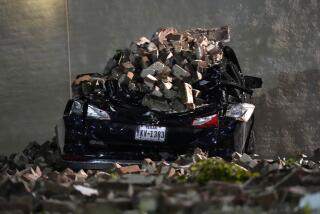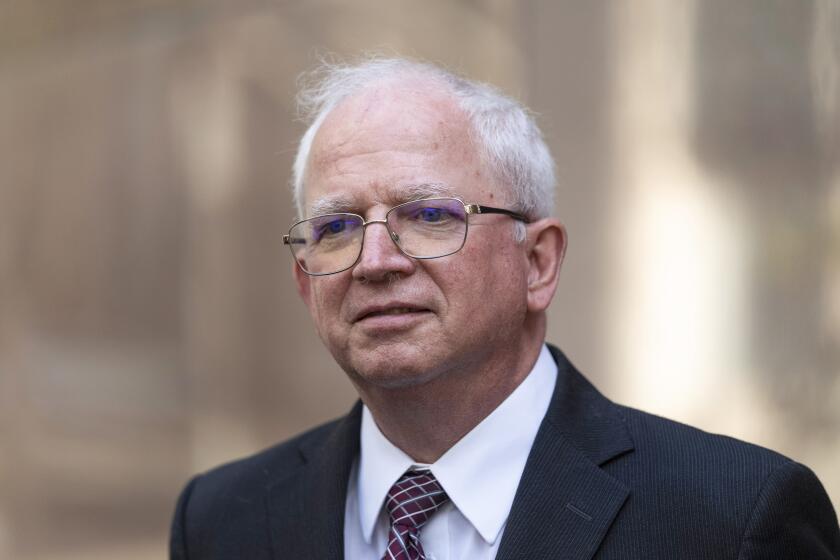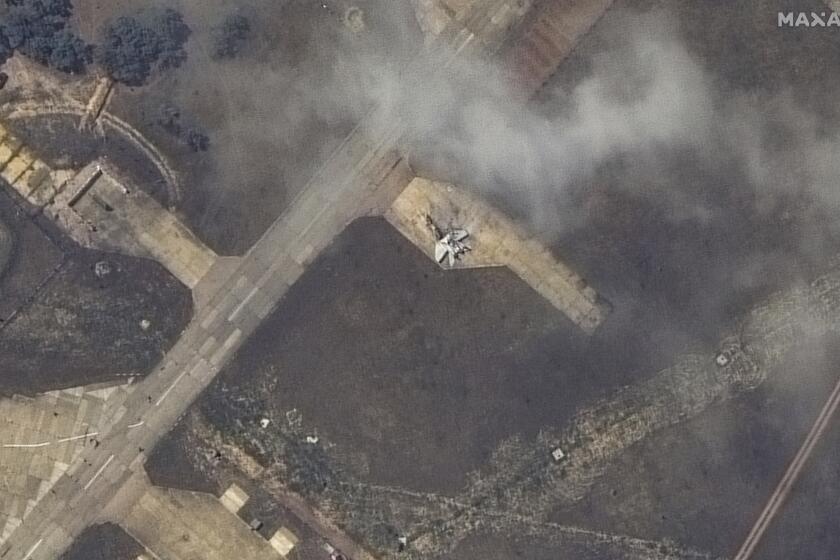Paper Mill Project Splits Latin Neighbors
The slender smokestack of the new paper mill rises from the shore of the Uruguay River like an all-seeing sentinel -- a beacon of hope for some, a cause of despair for others.
The soaring chimney has become emblematic of the bitterest dispute in generations between the countries on either side of the river, Uruguay and Argentina. The two share a European immigrant heritage and much more -- a singular style of Spanish, as well as a passion for soccer, grilled meat, mate tea and tango -- but find their economic and political interests at odds in this sleepy river town.
On one side of the river, Uruguayans defend two paper mills planned for construction in Fray Bentos as essential to economic recovery. In Argentina, protesters only last week ended a prolonged border blockade of two heavily traveled bridges across the river, maintaining that the plants will bring pollution and threaten their tranquil agrarian lifestyle.
“This is really very painful for us, very painful,” said Omar Lafluf, a veterinarian and mayor of Fray Bentos, which is still reeling from the shuttering of a giant meat-processing complex a generation ago. “We are brothers. We have always lived together. And now this.”
On Sunday, Finnish pulp and paper company Oy Metsa-Botnia said it would suspend construction on one of the mills for as many as 90 days to allow Uruguay and Argentina to study the project’s environmental effect.
The builder of the other mill, Spain-based Grupo Empresarial ENCE, has said it is willing to cooperate with the Uruguayan government, but it was not clear whether it would suspend construction.
The two countries’ presidents, Tabare Vazquez of Uruguay and Nestor Kirchner of Argentina, plan to meet Wednesday in Colonia del Sacramento, Uruguay, to begin discussions on resolving the deadlock.
The mills are scheduled to begin operations next year and are projected to manufacture about 1.5 million tons of paper pulp a year for wrapping material and other products, mostly for the European market.
The total projected investment of $1.8 billion is more than 10% of Uruguay’s gross domestic product and the largest private foreign investment in the history of this nation of 3 million people. What Uruguay lacks in hard cash it hopes to make up in natural resources -- water and trees -- that are vital to a paper industry gone global in search of the right conditions.
For the 25,000 residents of depressed Fray Bentos, the plants promise a return to the good fortune enjoyed during its more than century-long run as a transatlantic food exporter. The town once billed itself as “kitchen to the world,” delivering millions of tons of tinned corned beef and other meat products from slaughterhouses and canneries to the tables and armies of a voracious, often warring Europe in the 19th and 20th centuries.
“In the past, it was cattle” that brought prosperity, said Rene Boreto Ovalle, a town native and amateur historian who runs a museum on the grounds of what was once the teeming food-processing complex. “Now it is paper.”
But the prospective return to the global economy has collided with the intense opposition of neighboring Argentines, who say pollution from the mills will poison the Uruguay River, the murky border waterway that is a center for fishing, boating and bathing. The river also runs along Argentina’s fertile northeast delta region, known as Mesopotamia, a hub of cattle farming and the important soybean-growing industry.
“What good is land, what good is gold, what good are diamonds if they destroy the environment and people’s health?” asked Nelly Pivas, a 65-year-old grandmother who is part of the grass-roots opposition movement. “This is not good for us, nor for our Uruguayan brothers and sisters.
“We don’t want to see all that we love about this place destroyed.”
The standoff has become a global environmental cause celebre, with Greenpeace activists working locally to block water-borne supplies for the plants and solidarity movements around the world backing the protesters.
Opponents in Argentina point to pollution blamed on an ENCE paper pulp plant in Pontevedra, Spain, as a chilling portent.
“They can’t get away with this kind of dirty technology in Europe anymore, so they want to export it here to the Third World,” said Alfredo Munoz, a singer and protester from Gualeguaychu, on the Argentine side of the river.
The prosperous city of 80,000 has become ground zero for the opposition movement. Signs declaring “No to the Paper Plants” are everywhere one looks, and most everyone seems to have acquired an environmental consciousness.
“We cannot stand by and let this happen to our land and country,” Munoz said.
The border shutdown cost Uruguay tens of millions in tourist dollars and commercial business while triggering a diplomatic crisis on a scale not seen since the country broke off relations with a pro-Nazi regime in Buenos Aires more than half a century ago.
“This has been a catastrophe for us,” Dardo Paes, owner of the duty-free shop just inside the Uruguayan border, said as he stood in an aisle devoid of clients, alongside French perfume, name-brand clothing, single-malt Scotch and cases of Cuban cigars. “We all have friends or families on both sides of the border. Now there is this tension.”
Complicating any prospective resolution is a deeply wounded sense of national pride in both countries.
Uruguayan authorities and representatives of the companies have insisted that the plants will comply fully with international environmental standards. The bleaching technology to be used, known as elemental chlorine free, is a relatively clean method that is employed in European mills, supporters say.
The Argentines have been derided as hypocrites here because Argentina itself is host to almost a dozen paper plants that employ an older technology that Vazquez has called highly polluting.
“That won’t happen in Uruguay,” he vowed.
In a visit to Venezuela this month, Vazquez called the border blockades “a brutal aggression” and likened his country’s plight to that of Cuba, whose communist government has been banned from trading with the U.S. for decades.
Such criticism is especially pointed in contemporary South America, where Vazquez and Kirchner are part of a new generation of leftist leaders on warm terms with Cuba’s Fidel Castro and Venezuelan President Hugo Chavez, Latin America’s most prominent U.S. critics.
The paper war -- dubbed “Pulp Friction” by one headline writer -- has underscored the differences among South America’s ascendant leftist governments, which pursue often-conflicting agendas in search of economic advantage.
Kirchner has, in effect, backed the bridge blockaders. He would not send police to open the border crossings, something he has not hesitated to do elsewhere when marchers blocked roads, a common protest tactic in Argentina. His administration has threatened to take Uruguay to the International Court of Justice in The Hague.
On the hushed streets of this Uruguayan town, where the occasional 1930s roadster accentuates a sense of being lost in time, residents wonder why their Argentine friends and relatives have turned against them. The riverside resort of Las Canas, long popular with Argentine campers, saw a dramatic drop in business this summer.
“What can we do?” asked an exasperated Mayor Lafluf, sipping strong mate through a metal straw as he spoke in a conference room of the venerable City Hall. “I guess I could act like a great Uruguayan nationalist, call the people to the plaza and march to the bridge. But ... what good would that be?”
Across the river, the current cooling-off period has sparked Argentine fears of a sellout.
“This is something being worked out between Buenos Aires and Montevideo, but people there don’t even know the Rio Uruguay and are not taking us into consideration,” said Enrique Caballero, 60, a writer and craftsman who is among the protesters. “We have to make them understand that this is not a tango. This is real life.”
Researcher Andres D’Alessandro of The Times’ Buenos Aires Bureau contributed to this report, and Reuters was used in compiling it.
More to Read
Start your day right
Sign up for Essential California for news, features and recommendations from the L.A. Times and beyond in your inbox six days a week.
You may occasionally receive promotional content from the Los Angeles Times.






